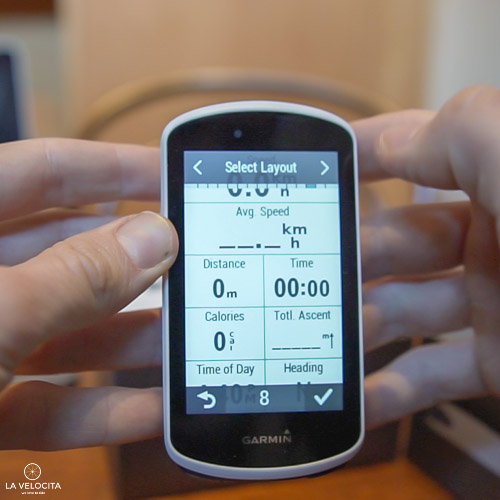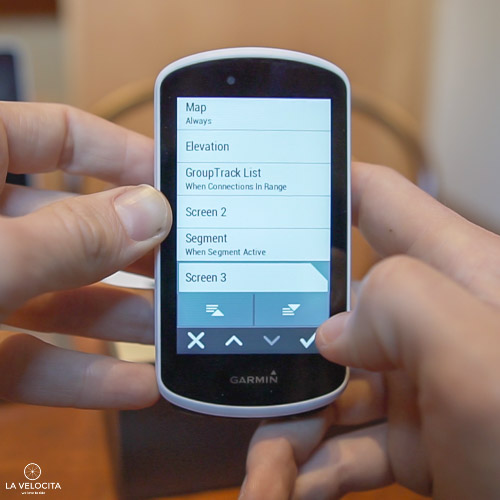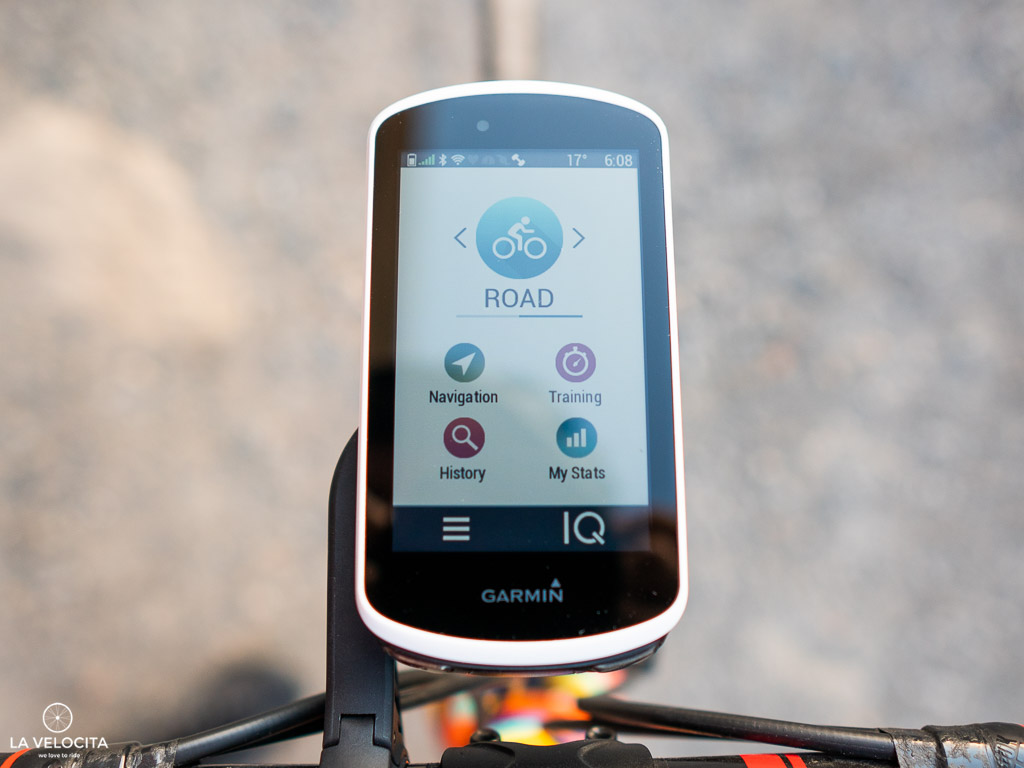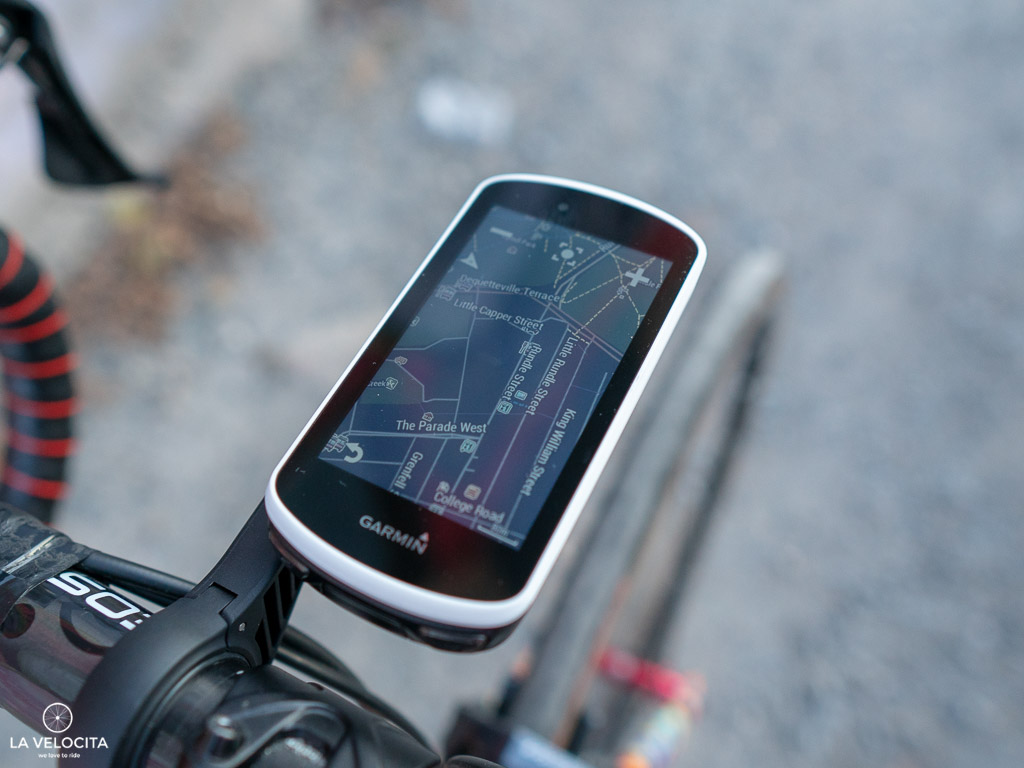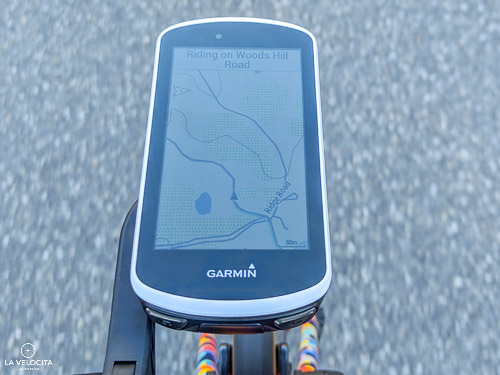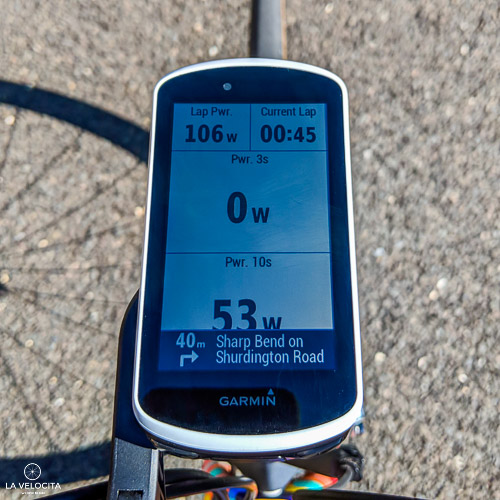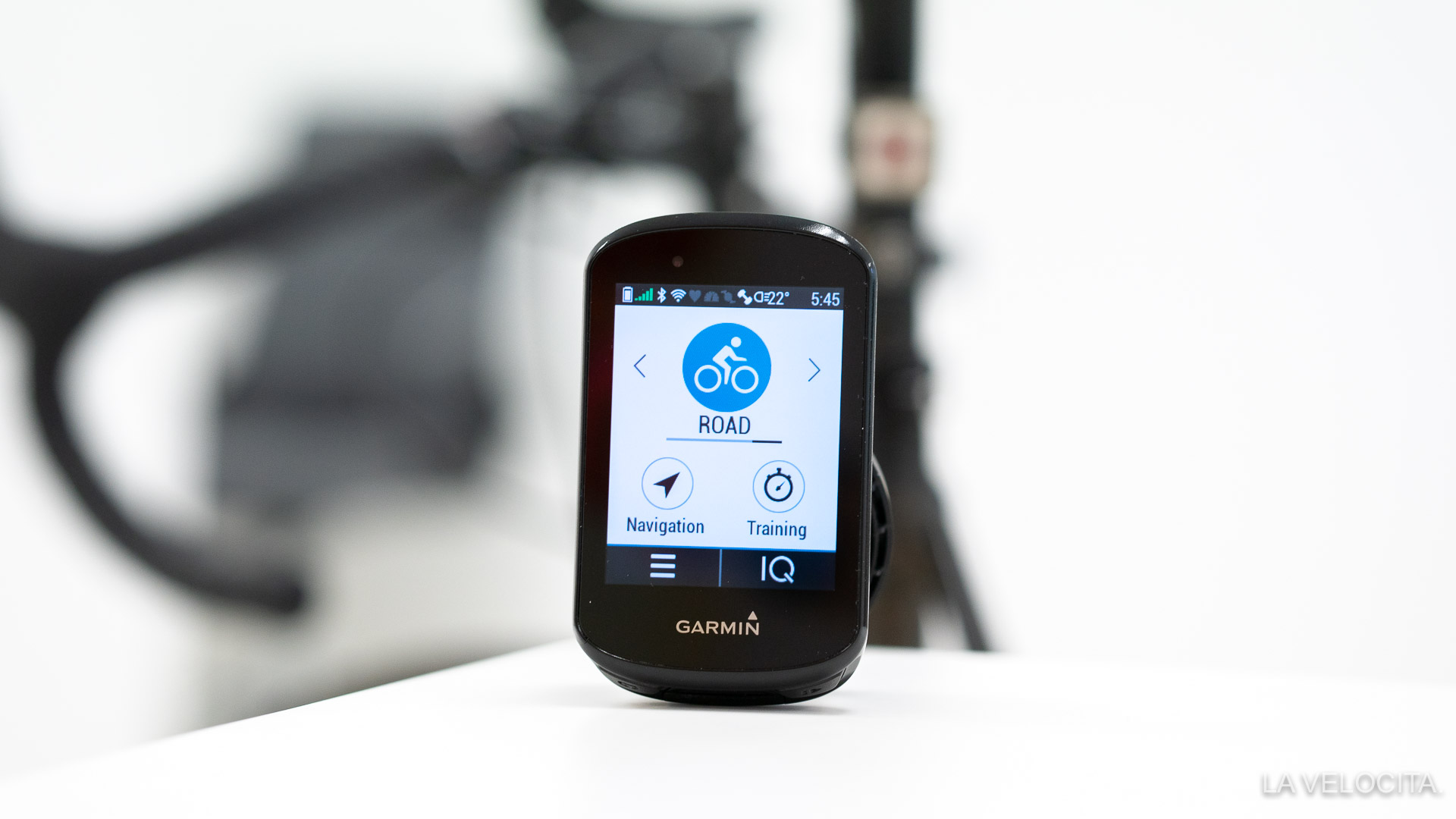Garmin Edge 1030 review

The biggest and badass-est Garmin Edge ever
Words and images - James Raison
Hot on the heels of reviewing the 520 Plus, the Edge 1030 arrived from Garmin Australia. I felt quite like a disappointed parent reviewing the 520 Plus; I just know you’re capable of better than this Garmin. The 520 Plus is the talented but underperforming GPS with great tech and tons of features held back by a bad interface and sub-par user experience. Then I cracked into the Edge 1030 and switched from disappointed parent to fawning, irrational and insufferable private school parent; my GPS* is better looking, more talented, smarter, and has better career prospects than yours. Then the bill for the 1030’s fancy education came through; $750 for just the head unit. My god… that’ll get you a good set of wheels...
You got some serious work to do 1030!
*100% not my GPS, this was a review unit
UNIT INFO
Size: 58 x 114 x 19
Weight: 123 g
Display: 3.5” size, 282 x 470 pixel resolution
Battery life: up to 20 hours
Storage: 16 gb internal + microSD slot
Ride history: up to 200 hours
GPS / GLONASS
Barometric Altimeter
Accelerometer
Price: $749 for the base unit, $849 for the bundle
SETUP
I’m torn on the 1030’s setup. There’s no smart-phone integration beyond giving a few personal stats. I’ve whined about this before with the 520 Plus; smartphone setup is an expected feature in 2018 and it’s weird that Garmin haven’t done it. That said, the 1030’s touchscreen makes this the easiest Edge I’ve ever set up by a long way. An interface refresh for the 820 and 1030 are very welcome and it makes things so much easier. Garmin’s complex and deep menu structure is still here but it’s been improved.
There’s the familiar Activity Profile starting point where you create your data screens and configure alerts, auto features, timer details, navigation, GPS/GLONASS, and a few other things.
Data Screens are where you’ll spend a lot of time. There’s a staggering array of that the unit to display. If you can imagine it, there’s probably an option for it. Setting the screens is easy with the touch capability and it didn’t take me long to have my standard 3-page layout. Then I dove into some of the more creative data displays under the Graphical menu. You can watch graphs and bars display all kinds of data. It’s a bit of fun, but not necessarily more useful than a normal number value.
You can activate and de-activate the standard suite of Garmin pages including; compass, elevation, lap summary, virtual partner, and a few others. I like that you can re-order them, allowing me to put the Live Segment screen adjacent to my power screen so I didn’t need multiple swipes to move between the two.
There’s more device options under the System menu where you can change Screen, Unit and Data Recording, Tones, and reset the device.
Naturally, connecting the unit to all of the Garmin sensors, and my Stages power meter was a breeze. It didn’t take too long until I was ready to roll.
HARDWARE
The 1030 is a gorgeous piece of hardware, peerless among bike GPS units. Its massive colour screen is wrapped with slender bezels. There’s only three buttons; on/off on the edge, and start/pause, and lap on the bottom. There’s a hard plastic charge port cover on the bottom edge too and even that is nice. Everything feels solid and substantial with firm buttons that have a nice click. This unit feels like the apex of the market.
It is awfully big, but I completely forgot about that after a couple of rides. Be prepared for people to comment that you might as well just mount your phone on the bars. I heard that one a lot! Yes, it’s big. But it’s worth it.
SCREEN
The 1030’s 3.5” 282x470 px screen is lovely. The detail is excellent, the colours are crisp without being obnoxious, and it’s very easy to read. Many baulk at the size of it, but it feels like every time you upgrade to a bigger phone. It just feels normal once you’ve adjusted. As with smartphones, usability increases with size. It create options for more data, easier to read fields, more display options, better maps, and better use of colour.
Admiring the Garmin’s facade is only half of it. You’ll be spending a lot of time poking it in the face. Yup, it’s a touch screen.
THE MAGIC TOUCH
I’m quite ambivalent towards the Edge 1030’s touch screen. It’s the best touch screen for a bike GPS I’ve used, but it’s still sluggish compared to smartphones. It makes setup substantially easier than using just buttons on the unit sides like the Edge 520 Plus, but I’d take smart phone setup any day.
At its best the touch screen makes setting up the unit and navigating the map a breeze. You can scroll up and down through the menus and operate sliders with relative ease. Again, it’s not smartphone fast but it’s ok. Free scrolling around the map is easy and can quickly show you what’s in your general vicinity. I did have to laugh at myself trying to pinch and expand the map to change elevation. Those habits are hard to forget. Unfortunately there aren’t gestures enabled.
I still prefer buttons while riding though because pressing is quicker than than swipes. Most units have their page scroll buttons on the side of the case which makes it easy to change screens and navigate menus while holding the bars. It’s not so easy having to swiping and tapping the 1030’s face when riding. Even on high responsiveness some swipes didn’t register and it drove me nuts when I was deep into an effort and swipes wouldn’t work. Further, I’m a clean screen zealot too and constantly sliding your sweaty, sticky, or sunscreen-y hands across the unit’s face makes a mess of the beautiful display.
COMMUNICATIONS
There’s quite a lot of communicating options from the 1030. All the expected call and text notifications are here so I won’t delve into that. It has plenty of other options to look at.
The first is Live Track; a feature that’s been around for a few years now. Basically, you can set up a map with you on it and send the link to anyone who might want to know where you are. Group Track is available here too, so you and any mates with compatible Garmins can see each other’s locations. I’m pointing it out, like I did in the 520 Plus review, but I didn’t use it. None of my ride buddies have recent enough Garmins.
One feature I liked was the message response. You have the option to reply to messages received while riding with a limited number of phrases. It includes simple positive and negative responses, and basic instructions. So I could get a message and a couple of taps later have replied saying I was out riding and would call be in touch later (I forget the exact wording). It’s nice to send responses without stopping and whipping out your phone.
The last noteworthy item is the incident detection. The Edge 1030 can use the accelerometer to determine whether you may have crashed and might need help. It can get in touch with a nominated contact and send your location in case you need help. It’s a cool feature and will give peace of mind to many people.
MAPS AND NAVIGATION
The 1030 couples its gorgeous screen with the best maps available on a bike GPS.
Drill down through the bike profile menu and into the Navigation menu where you’ll find a mind-blowing number of Map and Navigation options. You can tweak the display if you want certain zoom levels, different text size, and even relief detail. There’s even 5 different details settings; Most, More, Normal, Less, Least. Helpful icons will pop up
Stored in the unit’s navigation menu are “POIs” - Points of Interest - that the unit can guide you towards. You can choose a ridiculous array of options from fast food, to hospitals, to florists, parks or gardens, police stations, yacht clubs, or phone boxes. It’s funny looking through all the options and wondering when you’ll be out riding and suddenly need to be guided to a tattoo parlour. Yes, I was able to get directions to a tattoo parlour on the Edge 1030.
Just note that the units only have maps for their purchase region. Garmin’s maps for the rest of the world must be bought, or you can do some internet digging and find ways to add maps from other services.
NAVIGATION
The 1030 comes pre-loaded with the Strava Routes app under the Connect IQ menu. Connect your Garmin and Strava, and you’ll be able to access all of your Strava Routes and give full turn-by-turn guidance as if it were a Garmin created course. I first used it with the 520 Plus and it works well. Strava is my route creator of choice so I love this feature.
This photo doesn’t do the maps justice. Photographing Garmins on the move is hard!
ROUTE CREATION
Routes can be made using just the 1030 head unit in a couple of ways; getting the unit to design a route according to some criteria and your start/end point, or creating it by dropping pins.
The first option is trusting the Garmin to stitch a route together after giving it start point, end point and some basic criteria. The first option is popularity routing so it’ll choose according well-trodden bike routes. Next are the specifics of bike/vehicle type; road bikes, gravel bikes, MTB, motorbikes, pedestrian, car, and straight line. You can tell the 1030 what to avoid; major highways, toll roads, unpaved roads, ferries, and narrow trails. Then there’s calculation methods that can be set to minimise distance, time, or ascent. It all comes together to be incredibly specific. You could tell it to preference flat, unpaved roads for your gravel bike, or perhaps some hilly and narrow trails on for your mountain bike. I was slightly tempted to give it conflicting instructions like preferencing trails for my road bike but frankly I didn’t want to go out and see where it took me.
Testing out the route creation was hit-and-miss, with the input instructions for course creation seeming to give me conflicting routes. The popularity routing was smart enough to take me up popular roads, and use bike infrastructure. Great to see that in action. But it also took me on some very inefficient jaunts as it chose popularity over directness. Some routes had many kms of going in the wrong direction because it snapped to popular spots.
Here’s a side-by-side of map quality and clarity between a 1030 and Wahoo ELEMNT Bolt
The next method of dropping pins is fiddly but you get the hang of it. You can start it at specific points, coordinates, your current location, or just scroll around and drop a pin. You then add more points until asking the 1030 to link them all up into a route. I recommend adding plenty of points to avoid the 1030 having to make many assumptions. Its calculation method is based on choosing whether you want to minimise distance, time, or ascent. The easiest and most direct route is not necessarily the best though. Nonetheless, it’s cool to be able to create a route on the device. Still, the Strava Routes app makes this feature a little redundant when you can whip out your phone and use Strava to make a route much quicker then access it through the Connect IQ menu.
TURN-BY-TURN
Garmins are darn good at directing you once a course has started. You’ll get plenty of warning bleeps, a distance countdown, and big arrow overlaid on the map. There’s an interesting sharp turn warning that runs all the time and gives you a bleep and text warning of potentially dangerous corners. It’s a feature with potential but its overzealousness made me turn it off. I don’t need that distraction when heading towards a sharp bend.
THE RIDE
The 1030 is a nice unit to ride with, largely thanks to that lovely display and the excellent maps.
I like data. A lot. I run anywhere between 2-4 data pages with at least 3 screens depending on what bike I’m riding and they’ve never been so easy to read. The long out-front mount meant the unit didn’t feel big as it perched out ahead of my bars. As stated above, you forget just how big this thing is.
Plenty of space for your fields and even a sharp turn warning!
I came to enjoy having the map screen on with a couple of data screens discretely stashed at the bottom. Always displaying the maps gives a greater sense of place. I could keep an eye on side roads and any other points of interest that might appear adjacent to me. It, weirdly, added to the sense of progress as the little arrow trundled along on the screen. It seems the experience of moving through space is enhanced by seeing digital confirmation. My brain is weird.
The touch screen is nice when it responds to your swipes and presses. It’s quick and easy to navigate through the menus and change something on the fly. Frequently it didn’t register swipes, which could be particularly annoying during efforts when you have to quickly take a hand off the bar.
Battery life was surprisingly good considering all of the features and background processes that run. I was expecting it to be abysmal. This is the unit Garmin developed an external battery for, after all. After a 170 km ride I still had around 68% battery left. I was not making any effort to run it efficiently, neither was I using intense features. It passed the “normal use” battery test just fine. They’ve stashed a battery saver mode away in the settings if you want to strip back on the screen use and some features and really stretch it out.
TRAINING AND STRAVA INTEGRATION
There’s TrainingPeaks connectivity, but as with the 520 Plus, I didn’t test it because TrainingPeaks is not a cheap enough service for me to buy just during GPS tests.
There’s basic workout creation in Garmin Connect. It works ok and doesn’t cost anything so it’s a good starting point for people who want to try structured workouts for free.
I always devote time to Strava integration because I, and many others, love some Strava segment chasing. As mentioned above, the Strava Route app is great. Live segment tracking is very good too; with plenty of options for what time, person, or spot on the leaderboard you want to be tracked against. The display is nice, with an elevation graph, time comparison, and segment distance countdown. No other brand does Live Segment integration this well.
There’s a Segment Explorer feature accesses by the swipe down menu that’s… broken… I managed to use it maybe twice. All of the segments on the list disappeared within two seconds and the 1030 told me I had to connect to a phone. It even happened when my phone was showing as a connected device. When it worked, you could choose a segment from a list, get routed to it, and instruct what time you wanted to target. It was a nice feature when it worked. Which it didn’t most of the time.
POST-RIDE
Once the pedals have stopped there’s the standard speedy Garmin Bluetooth upload. It’ll present you with a bunch of performance, fitness, and analysis metrics. There’s a Training Effectiveness score that tells you if the completed activity will improve, maintain, or cause a regression in your fitness. It’ll even give you V02 Max and FTP metrics. It’s all very cool. I’ve griped before that it’s hard to sync these stats across devices. You have to use Garmin Express which required installing more desktop software.
THE GARMIN BUGS
The 1030 is proof that no Garmin, regardless of expense, will ever be free from bugs and glitches. It’s always struck me as strange that a market leader could ship the buggiest units I’ve tested.
My problems were a strange array of non-replicating and seemingly random crashing. It switched itself off multiple times during initial setup. Sometimes it locked up when switching off. The course creator caused it to freak out and shut down too.
The phone-connectivity features frequently didn’t work too, as the 1030 couldn’t decide whether my phone was connected. It would almost always show as “Searching” while I was riding, meaning I was locked out of several features, but could still use others. Sometimes my phone would show as a connected device but features would be blocked because of no phone connection.
Thankfully there were no crashes during activities or lost files. It all happened while playing with the 1030.
WRAPPING UP
The Garmin Edge 1030 is the best cycling GPS I’ve used. I love the massive screen, the detailed maps, most of the Strava integration, routes and direction instructions, and many of the features. It even has solid battery life by Garmin standards. It packs plenty of brilliance into its slender case.
There’s just so much filler in there. Do cyclists really need everything in a 1030? The fact it can navigate you to a florist is the perfect encapsulation of the unit. It’s beautiful hardware stuffed with more features than anyone could possibly need or use in the smartphone age. I’ve tested 7 GPS units from 4 different manufacturers in the last 18 months and I’ve realised how few features I use and what I really value; smartphone integration, maps with guidance options, and decent battery life. Too many units have all of that for a lot less money and in compact packages.
This is a unit for the tech nerds. Those who want the best and have a long list of required features. For me, I’ll go back to smaller and simpler units. I’ll miss the 1030 though.
Disclosure statement: This was a review unit that will be sent back to Garmin Australia.

